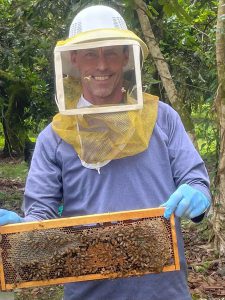
Ann Harman
Get it touch
ahworkerb@aol.com
By: Ann Harman
From Washington …… To Washington
Jay is originally from Seattle in Washington State. Since his mother worked in a natural history museum Jay was introduced to the natural world at an early age. Fortunately his family enjoyed outdoor activities. He discovered the fascinating ocean world of the Northwest coast while fishing, exploring along the coast and bays and also working, as a teen, in a family shellfish operation. So the clams and oysters, along with other ocean life inspired him to become a marine biologist.
With that goal in mind he went East and became a student at Princeton, an excellent university but one with absolutely no courses in marine biology. That was an incredible disappointment. (There are none there today either.) Fortunately he discovered the ecology courses. In those Jay found some excellent mentors. One introduced him to the world of insects, in particular social insects. But these were ants, no honey bees yet in his life.
After graduating from Princeton, Jay went West, to the Rocky Mountain Biological Laboratory, a field biology station in Colorado. Here in the western mountains Jay spent the next ten years working on his PhD and subsequently as a post-doc. His PhD is actually from the University of Utah and his research was on a particular ant, Myrmica tahoensis. It has no common name. It is rarely mentioned in scientific literature even today. But Jay found its biology of raising multiple queens, something that occurs in some species of ants, fascinating. Fortunately during his research there Jay was able to work with some top evolutionary biologists and geneticists in a collaborative project with their Human Genetics program.

The Arnot Forest is an old-growth forest that belongs to Cornell University. It is known to beekeepers from the studies Dr. Tom Seeley has done on survival of honey bee colonies that are nesting in trees. The trees with suitable hollows for honey bees have provided researchers an opportunity to study those bees in their natural environment. Jay was visiting and saw the sign to the forest but was not able to explore it.
With his knowledge of ants Jay headed East to the University of Georgia. Here he would be involved with a project to study the red imported fire ant. This ant can build large nests that have high mounds and can contain hundreds of thousands of ants. Their sting can be very painful and even dangerous to anyone allergic to their venom. It is an ant of the warmer regions and traveled here with cargo. The University of Georgia, as well as other southern institutions, does research on this ant. The ant does eat the small hive beetle larvae, our beehive pest. So although it itself is a formidable pest it does help beekeepers control the small hive beetle population.
Although the fire ant is considered to be a destructive and dangerous pest, Jay did not wish a career involved with finding ways to eradicate it. After all he had spent some years studying the interesting world of ants, a social insect. So he proposed and started a program at the University of Arizona (back to the West again) with a professor who was also an ant expert. However ants were not to be the insect of choice for this program. This time the investigation would focus on the production of queen honey bees. The bees were chosen because the topic should be easier with bees than using ants. It actually was, thanks to significant help from Dr. Gloria deGrandi-Hoffman at the USDA-ARS lab in Tucson.
Jay had actually met honey bees only once before the project started. He had visited some beehives in Georgia with a friend. Although he did not participate in the actual caring for the bees at the university, at least he now owned a bee suit with a veil. This project only lasted nine months. Jay had a new wife waiting for him back on the East Coast. He had met her when they both were at a summer camp for biologists. However they were connected to different universities. So it was time to return to the East.
At that time Dr. Hachiro Shimanuki (known to many as “Shim”) was Head of the USDA’s Beltsville Bee Research Laboratory (BRL) at the Beltsville Agricultural Research Center (BARC).
This laboratory, the oldest of the federal bee labs, was established in 1891. Then, as now, it is primarily concerned with honey bee diseases and pests, their identification and controls. USDA has several other bee labs throughout the U.S. that focus on other topics. Beekeepers may be familiar with the Beltsville lab’s services in diagnosing diseases such as American foulbrood. Beltsville, a town in Maryland, is only a short distance from Washington, DC. So when Jay was hired by Dr. Shimanuki, Jay had arrived at another Washington, but quite a bit different from the state out West.
Jay’s first project was to investigate how honey bees respond to American foulbrood as a disease in order to find controls for this and other bacterial bee diseases. However honey bees also have other pests so Jay’s work expanded to those and how honey bees react and combat them. Since he was now a part of this research team he was fortunately able to participate in the Honey Bee Genome Project. Jay appreciated the experiences he met on this project – the teamwork and coordination necessary for such an undertaking. He feels that the knowledge gained will help the honey bee confront diseases, mites, small hive beetles and environmental issues such as pesticides. Since the focus of the Beltsville Lab is bee health, the scientists there, in cooperation with others, are focusing on developing safe products for reducing bee diseases and also other stresses.
Jay enjoys his trips where he can meet not only with scientists from all over but also with beekeepers. One trip took him to England where he was able to travel to a number of local beekeeping clubs. One special visit was to Buckfast Abbey and the associated area of Dartmoor where Brother Adam developed the Buckfast bee. Another trip was to Brazil where Jay met with Dr. Warwick Kerr who brought the African bee, Apis mellifera scutellata, to his county for research.
Dr. Kerr admonished Jay for speaking too fast during his lecture to Kerr’s students. But after that all was well between the two bee scientists and Jay enjoyed his visit.
Bees are only a part of Jay’s life. He does enjoy running. Back in the 1980s he took up rowing a sculling boat, which he still does occasionally. He describes his Maryland home – a “hobby farm” complete with about 20 sheep and goats, chickens, five beehives and three teenagers. He admits they all eat a lot but are endlessly entertaining.
Since the Lab is part of the U.S. Government, Jay is following in his family history of civil servants. Although he is the only beekeeper, others were in politics, local issues, National Parks and county engineers.
Jay truly enjoys meeting all those involved in the world of honey bees – beekeepers and fellow scientists. All who keep bees need to thank Dr. Jay Evans and his team for the desire and hard work to improve honey bee health.
Ann Harman lives, writes and enjoys life in Flint Hill, Virginia.









